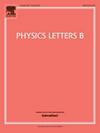富中子He超同位素的Gamow壳层模型描述
IF 4.5
2区 物理与天体物理
Q1 ASTRONOMY & ASTROPHYSICS
引用次数: 0
摘要
将伽莫夫壳模型(GSM)框架扩展到弱束缚超核的研究。作为初步应用,我们研究了从Λ6He到Λ9He的富中子He超同位素,准确地处理了超核多体态的非束缚或松散束缚特征。利用具有有效YN相互作用的现象学哈密顿量计算的能谱与现有的实验数据吻合得很好。特别是,预测了富中子核5−8He和超核Λ6He的中子发射共振态。此外,中子密度表现出弱束缚态和共振态的长程特性。该研究表明,GSM是描述超核复杂结构的实用工具,特别是对于那些靠近滴注线的超核。本文章由计算机程序翻译,如有差异,请以英文原文为准。
Gamow shell model description of neutron-rich He hyper-isotopes
The Gamow shell model (GSM) framework is extended to the study of weakly bound hypernuclei. As an initial application, we investigate the neutron-rich He hyper-isotopes from He to He, accurately treating the unbound or loosely bound character of hypernuclear many-body states. The energy spectra, calculated using a phenomenological Hamiltonian with an effective YN interaction, show good agreement with available experimental data. In particular, neutron-emitting resonant states are predicted for the neutron-rich nuclei 5−8He and the hypernucleus He. Furthermore, neutron densities exhibit the long-range character of weakly bound and resonant states. This study demonstrates that GSM is a practical tool for describing the complex structure of hypernuclei, especially for those close to drip lines.
求助全文
通过发布文献求助,成功后即可免费获取论文全文。
去求助
来源期刊

Physics Letters B
物理-物理:综合
CiteScore
9.10
自引率
6.80%
发文量
647
审稿时长
3 months
期刊介绍:
Physics Letters B ensures the rapid publication of important new results in particle physics, nuclear physics and cosmology. Specialized editors are responsible for contributions in experimental nuclear physics, theoretical nuclear physics, experimental high-energy physics, theoretical high-energy physics, and astrophysics.
 求助内容:
求助内容: 应助结果提醒方式:
应助结果提醒方式:


